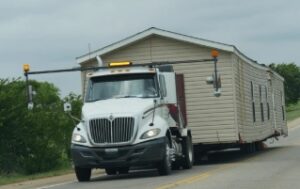Hurricane Cat 3 Safe, yet Transportable
You can expand each Orange heading by clicking on it to toggle it open.
Handling Hurricane Winds
WHAT DOES HURRICANE RESISTANCE MEAN?
We build houses that are Category 3 hurricane resistant, based on the ability to withstand specified wind gusts as specified in the
Saffir-Simpson Hurricane Wind Scale
| Category | Sustained Winds | Types of Damage Due to Hurricane Winds |
|---|---|---|
| 1 | 74-95 mph 64-82 kt 119-153 km/h |
Very dangerous winds will produce some damage: Well-constructed frame homes could have damage to roof, shingles, vinyl siding and gutters. Large branches of trees will snap and shallowly rooted trees may be toppled. Extensive damage to power lines and poles likely will result in power outages that could last a few to several days. |
| 2 | 96-110 mph 83-95 kt 154-177 km/h |
Extremely dangerous winds will cause extensive damage: Well-constructed frame homes could sustain major roof and siding damage. Many shallowly rooted trees will be snapped or uprooted and block numerous roads. Near-total power loss is expected with outages that could last from several days to weeks. |
| 3 (major) |
111-129 mph 96-112 kt 178-208 km/h |
Devastating damage will occur: Well-built framed homes may incur major damage or removal of roof decking and gable ends. Many trees will be snapped or uprooted, blocking numerous roads. Electricity and water will be unavailable for several days to weeks after the storm passes. |
| 4 (major) |
130-156 mph 113-136 kt 209-251 km/h |
Catastrophic damage will occur: Well-built framed homes can sustain severe damage with loss of most of the roof structure and/or some exterior walls. Most trees will be snapped or uprooted and power poles downed. Fallen trees and power poles will isolate residential areas. Power outages will last weeks to possibly months. Most of the area will be uninhabitable for weeks or months. |
| 5 (major) |
157 mph or higher 137 kt or higher 252 km/h or higher |
Catastrophic damage will occur: A high percentage of framed homes will be destroyed, with total roof failure and wall collapse. Fallen trees and power poles will isolate residential areas. Power outages will last for weeks to possibly months. Most of the area will be uninhabitable for weeks or months. |
We handle winds up to Category 3 (green )
North American (USA/Canada) standards aim for Category 2
The Category 4 and 5 hurricane winds are rare and we cannot handle winds at these levels.
HOW ARE TUFF+ Homes NOT BLOWN AWAY?
Prestressed concrete consists of high tensile steel wire tensioned in place before pouring concrete into the mould.
We can supply piles in prestressed concrete through our partners Sealand Prestressed; they are water and salt proof, and so strong that they can sustain hurricane strength winds.

We also use FRC POLTRUDED TUFF+ Beams as a foundational basis to meet stringent architectural requirements. These beams are comparative to steel for strength, but don’t rust, so can be laid directly onto compressed soil and with 40 foot (12 meter) lengths can allow our kit homes to be transportable as well. When locked into compressed soil they form an alternative to piles or slab foundations.
HOW ARE TUFF+ Homes strong enough to stop roofs lifting?
Critical damage in Hurricanes is generally started with the high wind creating an Airplane wing lift (aerofoil) effect over a gable roof.
TUFF+ Home kits avoid this by using flat roofs without a gable (Slope to drain water is one way)
HOW ARE TUFF+ Homes strong enough that they don’t break apart?
TUFF+ homes have a proprietory building method for making everything stronger than traditional cement walls or wooden stud frames.
This is called TUFF+ Interlock and ensures that the walls are locked into the side of the foundation, not just sitting on top.
So the house will not be pushed off the foundation by the lateral load!
You can learn more about TUFF+ Interlock in our kit homes inclusion package
Transportable TUFF+ Housing kits
Because our houses are based on strong TUFF+ FRP MAIN beams, they can be built onto compacted soil or integrated into piles, forming a foundation framework that can be transportable via a semi-trailer if the size is reasonable.
Enquire using the contact form if you are interested which housing kits are transportable as a finished building with floor, walls and roof.
NOTE all TUFF+ housing kits can be shipped in a flat pack form, allowing fast building onsite, from the container in which they are supplied.
NOTE TUFF+ housing kits are NOT container homes built from steel containers, they are built from the latest composite materials and don’t rust, nor do we use wood for structural purposes.
Providing a Solid Foundation for all soil types
In Central America there are many cenotes, or underground caves or sinkholes, occuring from the collapse of limestone bedrock.

In order to prevent the risk of foundations subsiding, Best EnviroHomes uses prestressed concrete piles to support the homes built where there is risk of subsiding soil or cenotes, which are common in Central America. This type of pile based foundation requires much less amount of concrete than a floating or slab poured foundation, and also is the least impact on the environment and water flow.
No matter the type of soil, piles can be used to provide more structural strength to the weak soil underneath, establishing a solid foundation for your home. Of course they involve more expense, so Best Envirohomes also has another alternative, horizontal piles, or horizontal TUFF+ beams which work well in locations with stable soil.
We partner with Sealand Prestressed for piles
With 25 years of business success in Belize, Sealand Prestressed is our choice of reliable manufacture of prestressed concrete piles, and they also have the equipment and knowledge for pile driving and much more.
Contact them by clicking their logo:



